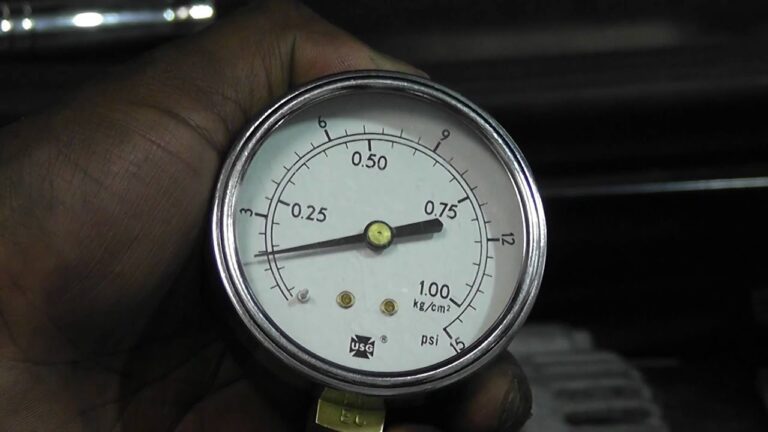what happens when you run out of brake fluid
Introduction
When you run out of brake fluid, it can be a dangerous situation. Brake fluid is a vital component of your vehicle’s braking system, and without it, your brakes will not work properly. Without brake fluid, your brakes will become spongy and unresponsive, and you may not be able to stop your vehicle in time. Additionally, running out of brake fluid can cause damage to your brake system, leading to costly repairs. It is important to check your brake fluid levels regularly and to replace it when necessary.
How to Identify the Signs of Low Brake Fluid
Low brake fluid is a serious issue that can lead to dangerous driving conditions. It is important to be able to identify the signs of low brake fluid in order to ensure the safety of yourself and other drivers.
The first sign of low brake fluid is a spongy feeling when the brake pedal is pressed. This is caused by air bubbles in the brake lines, which can be caused by a leak in the brake system. If the brake pedal feels spongy, it is important to have the brake system inspected immediately.
Another sign of low brake fluid is a grinding or squealing noise when the brakes are applied. This noise is caused by metal-on-metal contact between the brake pads and the rotors. If this noise is heard, it is important to have the brake system inspected as soon as possible.
The third sign of low brake fluid is a warning light on the dashboard. This light is usually yellow or red and indicates that there is a problem with the brake system. If this light is illuminated, it is important to have the brake system inspected immediately.
Finally, if the brake pedal is difficult to press or feels like it is sinking to the floor, this is a sign of low brake fluid. This is caused by a lack of pressure in the brake system, which can be caused by a leak or a faulty brake master cylinder. If this is the case, it is important to have the brake system inspected immediately.
It is important to be aware of the signs of low brake fluid in order to ensure the safety of yourself and other drivers. If any of these signs are present, it is important to have the brake system inspected immediately.
The Dangers of Driving with Low Brake Fluid
Driving with low brake fluid is a serious safety hazard that should not be taken lightly. Brake fluid is a vital component of a vehicle’s braking system, and when it is low, the brakes may not work properly. This can lead to a dangerous situation on the road, as the driver may not be able to stop the vehicle in time to avoid an accident.
When brake fluid is low, the brakes may not be able to generate enough pressure to stop the vehicle. This can cause the brakes to feel spongy or unresponsive when the driver presses the brake pedal. In some cases, the brakes may even fail completely, leaving the driver unable to stop the vehicle. This can be especially dangerous if the driver is traveling at high speeds or in heavy traffic.
Low brake fluid can also cause damage to the braking system. When the fluid is low, air can enter the system, which can cause corrosion and other damage. This can lead to costly repairs and can even cause the brakes to fail completely.
It is important to check the brake fluid level regularly and to top it off when necessary. If the brake fluid is low, it is important to have it checked by a professional mechanic to ensure that the brakes are working properly. Driving with low brake fluid is a serious safety hazard and should not be taken lightly.
How to Check Your Brake Fluid Level
Checking your brake fluid level is an important part of regular vehicle maintenance. It is important to ensure that your brake fluid is at the correct level in order to ensure the proper functioning of your brakes. Here is a step-by-step guide on how to check your brake fluid level:
1. Locate the brake fluid reservoir. This is usually located near the firewall of the engine compartment. It is a clear plastic container with a lid and a dipstick.
2. Remove the lid from the reservoir and wipe off any dirt or debris from the dipstick.
3. Insert the dipstick into the reservoir and remove it.
4. Check the level of the brake fluid on the dipstick. The fluid should be between the two marks on the dipstick. If the level is below the lower mark, you need to add more brake fluid.
5. If you need to add more brake fluid, use a funnel to pour the fluid into the reservoir. Make sure not to overfill the reservoir.
6. Replace the lid on the reservoir and make sure it is securely fastened.
7. Clean up any spilled brake fluid and dispose of it properly.
By following these steps, you can easily check your brake fluid level and ensure that your brakes are functioning properly.
The Benefits of Regular Brake Fluid Maintenance
Regular brake fluid maintenance is essential for the proper functioning of a vehicle’s braking system. Brake fluid is a hydraulic fluid that is used to transfer the force from the brake pedal to the brakes. It is important to keep the brake fluid in good condition in order to ensure that the brakes are working properly.
The most important benefit of regular brake fluid maintenance is that it helps to prevent brake failure. Brake fluid can become contaminated over time, which can lead to a decrease in the effectiveness of the brakes. Contaminated brake fluid can cause the brakes to become less responsive, which can lead to an increased risk of an accident. Regular maintenance helps to ensure that the brake fluid is clean and free of contaminants, which can help to reduce the risk of brake failure.
Another benefit of regular brake fluid maintenance is that it can help to extend the life of the brakes. When the brake fluid is kept clean and free of contaminants, it can help to reduce the amount of wear and tear on the brakes. This can help to extend the life of the brakes and reduce the need for costly repairs or replacements.
Finally, regular brake fluid maintenance can help to improve the performance of the brakes. When the brake fluid is kept clean and free of contaminants, it can help to improve the responsiveness of the brakes. This can help to improve the overall performance of the vehicle and make it safer to drive.
In conclusion, regular brake fluid maintenance is essential for the proper functioning of a vehicle’s braking system. It can help to prevent brake failure, extend the life of the brakes, and improve the performance of the brakes. Therefore, it is important to ensure that the brake fluid is kept clean and free of contaminants in order to ensure the safety and performance of the vehicle.
What to Do When You Run Out of Brake Fluid
If you find yourself in a situation where you have run out of brake fluid, it is important to take the necessary steps to ensure your safety and the safety of those around you.
First, you should immediately pull over to a safe location and turn off your engine. Once you have done this, you should check your brake fluid reservoir to make sure that it is indeed empty. If it is, you should then check your owner’s manual to determine the type of brake fluid that is recommended for your vehicle.
Once you have identified the type of brake fluid that is needed, you should purchase the appropriate amount from an auto parts store. When you are ready to fill the reservoir, make sure that you are wearing protective gloves and eyewear. You should also ensure that the area is well-ventilated, as brake fluid is highly flammable.
Once you have filled the reservoir, you should start your engine and pump the brakes several times to ensure that the brake fluid is distributed evenly throughout the system. You should then take your vehicle for a test drive to make sure that the brakes are functioning properly.
It is important to note that running out of brake fluid can be a sign of a larger problem with your braking system. If you experience any issues with your brakes after refilling the reservoir, you should take your vehicle to a qualified mechanic as soon as possible.
How to Refill Your Brake Fluid Reservoir
Refilling your brake fluid reservoir is an important part of maintaining your vehicle. It is important to ensure that the brake fluid is at the correct level in order to ensure that your brakes are functioning properly. This guide will provide you with the steps necessary to refill your brake fluid reservoir.
1. Begin by locating the brake fluid reservoir. This is typically located near the brake master cylinder, which is usually located near the firewall of the vehicle.
2. Once you have located the reservoir, remove the cap.
3. Check the level of the brake fluid. If the level is low, you will need to add more fluid.
4. Use a funnel to pour the brake fluid into the reservoir. Make sure to use the correct type of brake fluid for your vehicle.
5. Once the fluid has been added, replace the cap on the reservoir.
6. Start the engine and press the brake pedal several times to ensure that the brakes are functioning properly.
7. Check the level of the brake fluid again to make sure that it is at the correct level.
Following these steps will help ensure that your brake fluid reservoir is properly refilled and that your brakes are functioning properly. It is important to check the level of the brake fluid regularly and to refill it as needed.
The Cost of Replacing Brake Fluid
Replacing brake fluid is an important part of regular vehicle maintenance. Brake fluid is a hydraulic fluid that helps to transfer the force of the brake pedal to the brakes, allowing them to stop the vehicle. Over time, brake fluid can become contaminated with moisture, dirt, and other debris, which can reduce its effectiveness and cause damage to the braking system. Replacing the brake fluid is necessary to ensure that the brakes are functioning properly and safely.
The cost of replacing brake fluid will vary depending on the type of vehicle and the amount of fluid needed. Generally, the cost of replacing brake fluid will range from $50 to $150. This cost includes the cost of the brake fluid itself, as well as the labor costs associated with replacing it.
In addition to the cost of the brake fluid, there may be additional costs associated with replacing it. For example, if the brake system needs to be flushed, there may be additional labor costs associated with this process. Additionally, if the brake system needs to be inspected or repaired, there may be additional costs associated with this as well.
It is important to note that replacing brake fluid is not a difficult process, and it can be done relatively quickly. However, it is important to ensure that the job is done correctly, as improper installation can lead to serious safety issues. Therefore, it is recommended that the job be done by a qualified mechanic.
In conclusion, replacing brake fluid is an important part of regular vehicle maintenance. The cost of replacing brake fluid will vary depending on the type of vehicle and the amount of fluid needed, but generally, the cost will range from $50 to $150. Additionally, there may be additional costs associated with replacing the brake fluid, such as flushing the system or inspecting and repairing the brakes. It is important to ensure that the job is done correctly, so it is recommended that the job be done by a qualified mechanic.
How to Avoid Running Out of Brake Fluid
Brake fluid is an essential component of any vehicle’s braking system, and running out of it can be dangerous. To ensure that you never run out of brake fluid, it is important to follow a few simple steps.
First, check your brake fluid levels regularly. Most vehicles have a reservoir for the brake fluid, which should be checked at least once a month. If the fluid level is low, it is important to top it up with the correct type of brake fluid. It is also important to check for any signs of leakage, as this can lead to a decrease in brake fluid levels.
Second, have your brakes inspected regularly. During a brake inspection, a mechanic will check the brake fluid levels and look for any signs of wear or damage. If any issues are found, they can be addressed before they become a major problem.
Third, replace your brake fluid regularly. Brake fluid can become contaminated over time, which can lead to a decrease in performance. It is recommended that brake fluid be replaced every two years or 24,000 miles, whichever comes first.
Finally, if you notice any changes in your vehicle’s braking performance, it is important to have it checked out immediately. This could be a sign of a problem with the brake system, such as a leak or worn components.
By following these steps, you can ensure that you never run out of brake fluid and that your vehicle’s brakes are always in top condition.
Q&A
1. What happens when you run out of brake fluid?
Without brake fluid, your brakes will not be able to generate enough pressure to stop the vehicle. This can lead to a dangerous situation where you are unable to stop the vehicle in time, resulting in an accident.
Conclusion
When you run out of brake fluid, your brakes will not work properly and you may not be able to stop your vehicle. This can be a very dangerous situation and can lead to serious accidents. It is important to check your brake fluid levels regularly and to top them up when necessary. If you are ever in doubt, it is best to consult a professional mechanic to ensure that your brakes are in good working order.



